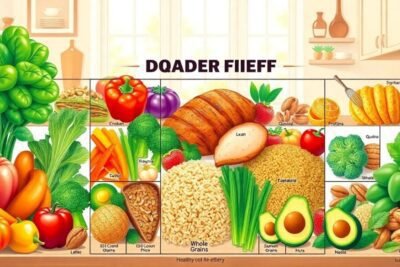
Popcorn, a whole grain snack, is often a subject of curiosity for those managing diabetes. Its high fiber content and low calorie count can make it an attractive option, but how does it really fit into a diabetic diet?
Understanding the impact of popcorn on blood sugar is essential for individuals with diabetes. Let's explore the nutritional aspects of popcorn and its effects on blood sugar levels.
What you\'ll find in this article?
- What Is the Glycemic Index of Popcorn and Why Is It Important?
- Does Popcorn Raise My Blood Sugar?
- How Much Popcorn Should A Person With Diabetes Eat?
- What Are The Ingredients To Limit In Popcorn?
- Can Diabetics Have Popcorn With Butter?
- What Are The Best Popcorn Alternatives For People With Diabetes?
- Is popcorn good for diabetics
- Can diabetics eat popcorn
- Popcorn and diabetes
- Popcorn blood sugar
- Popcorn glucose index
- Popcorn glycemic index
- Popcorn good for diabetics
- Can a diabetic eat popcorn
- Can prediabetes eat popcorn
- Glycemic index popcorn
- Is popcorn a good snack for diabetics
- Is popcorn high glycemic
- Is popcorn low gi
- Is popcorn ok for diabetics
- Popcorn and diabetics
- Popcorn for diabetics
- Popcorn good for diabetes
- Should diabetics eat popcorn
- Will popcorn raise blood sugar
- Air popped popcorn glycemic index
- Can diabetic eat popcorn
- Can i eat popcorn if i am diabetic
- Can type 2 diabetics eat popcorn
- Diabetes and popcorn
- Does popcorn affect blood sugar
- Does popcorn lower blood sugar
- Does popcorn raise blood sugar
- Gi value of popcorn
- Glycemic index for popcorn
- Glycemic index popcorn oil popped
- Frequently Asked Questions about Popcorn and Blood Sugar
- Glycemic load of popcorn
- How bad is popcorn for diabetics
- How much popcorn can a diabetic have
- Is air popped popcorn good for diabetics
- Is it ok for diabetics to eat popcorn
- Is popcorn a good diabetic snack
- Is popcorn a good snack for a diabetic
- Is popcorn a healthy snack for diabetics
- Is popcorn bad for diabetics
- Is popcorn bad for type 2 diabetes
- Is popcorn good for diabetes
- Is popcorn good for diabetics to eat
- Is popcorn good for diabetics type 2
- Is popcorn high in carbs for diabetics
- Is popcorn high on the glycemic index
- Popcorn diabetes 2
- Popcorn bad for diabetics
- Popcorn and blood sugar levels
- Is popcorn ok for type 2 diabetes
- Is popcorn ok for diabetics to eat
- Popcorn diabetes can eat
- Popcorn good or bad for diabetes
- Popcorn low glycemic
- Popcorn prediabetes
- Popcorn with diabetes
- Skinny popcorn good for diabetics
- Why does popcorn spike blood sugar
What Is the Glycemic Index of Popcorn and Why Is It Important?
The glycemic index (GI) is a measure of how quickly foods raise blood sugar levels. Foods with a high GI are quickly digested and absorbed, causing a rapid rise in blood sugar, while foods with a low GI have a slower absorption rate, leading to a gradual increase in blood sugar.
Popcorn generally falls into the low to medium GI category, with a score between 55 to 65. This makes it a favorable snack for diabetics when prepared correctly—without sugary toppings or excessive salt.
However, it's crucial to consider the glycemic load as well, which takes into account the serving size. A typical serving of air-popped popcorn has a glycemic load of 3.3, making it a decent choice for blood sugar management when enjoyed in moderation.
The fiber in popcorn also aids in digestion and can help maintain a feeling of fullness, reducing the risk of overeating. Adding a healthy fat source can further lower the glycemic impact, providing a more balanced snack.








Explore our specialized services in diabetes care 🌟.
From personalized diet plans to effective exercise routines, we have what you need to take control of Type 2 Diabetes.
Visit our services page now!
Does Popcorn Raise My Blood Sugar?
The question, "Does popcorn raise my blood sugar?", is not a straightforward one. While popcorn itself can be a good snack choice, its effect on blood sugar levels depends on several factors, including portion size and toppings.
The simple carbohydrates in popcorn can contribute to a spike in blood sugar if consumed in large quantities or with high-calorie additives like butter or caramel.
Moderation is key. Sticking to a portion of around 50 grams of popcorn can help maintain stable blood sugar levels, but individual responses can vary based on overall diet and physical activity.
For those looking to enjoy popcorn without worrying about a sugar spike, air-popped popcorn is the way to go. It's free of the unhealthy fats and sodium found in many commercial popcorns, making it a healthier choice.
How Much Popcorn Should A Person With Diabetes Eat?
When it comes to portion control for diabetics, the magic number for popcorn consumption tends to be one to three cups of air-popped popcorn. This amount allows for a satisfactory snack without overindulging in carbohydrates.
It's also beneficial to pair popcorn with protein or a healthy fat to balance the nutritional value and reduce the overall glycemic response. This can help prevent blood sugar levels from rising too quickly.
Every individual's dietary needs are different, so consulting with a healthcare provider or a dietician can provide personalized recommendations based on specific health goals and conditions.
What Are The Ingredients To Limit In Popcorn?
While popcorn can be a diabetic-friendly snack, certain ingredients should be limited to avoid negative impacts on blood sugar levels.
- Saturated fats, often found in butter or cheese toppings, should be consumed in moderation.
- Sugary coatings or seasonings can quickly turn a healthy snack into a high-carb, high-calorie treat.
- Excessive salt can lead to other health issues, such as increased blood pressure.
Choosing air-popped popcorn and adding your own measured toppings, like a sprinkle of nutritional yeast or a dash of cinnamon, can enhance the flavor without compromising blood sugar control.
Can Diabetics Have Popcorn With Butter?
Adding butter to popcorn is a common practice, but for individuals with diabetes, it's important to be cautious. While a small amount of butter can be part of a balanced diet, it's high in saturated fats, which can affect heart health and potentially lead to weight gain if consumed in large amounts.
Opting for healthier alternatives, such as a light drizzle of olive oil, can provide the desired flavor without the same health risks. Always measure the amount of butter or oil to avoid unintentional overconsumption.
What Are The Best Popcorn Alternatives For People With Diabetes?
For those seeking variety or looking for alternatives to popcorn, there are several nutritious options that can satisfy the craving for a crunchy snack.
- Nuts and seeds are excellent alternatives, offering healthy fats, protein, and fiber.
- Homemade protein bars or energy balls can provide a balanced blend of nutrients.
- Vegetable chips, made from kale or sweet potatoes, can be a tasty and nutritious choice when homemade.
These alternatives not only provide a variety of nutrients but can also help maintain stable blood sugar levels due to their lower glycemic index and higher fiber content.
Is popcorn good for diabetics
Popcorn can be a suitable snack for diabetics when consumed in moderation. It is a whole grain and has a relatively low glycemic index, which means it has a minimal impact on blood sugar levels compared to other snacks. However, portion control is essential to avoid excessive carbohydrate intake.
One of the benefits of popcorn is its high fiber content. Fiber plays a crucial role in slowing down the digestion process, which can help prevent spikes in blood sugar after meals. Opting for air-popped popcorn without added sugars or excessive fats can maximize these benefits.
It’s important to be cautious about what you add to your popcorn. Many commercial popcorn products come loaded with butter, salt, or sweeteners that can increase their calorie and carbohydrate content, potentially affecting blood sugar levels. Homemade popcorn allows for healthier seasoning options, like herbs or a light sprinkle of salt.
For those monitoring their blood sugar, popcorn can be a satisfying snack that provides a sense of fullness. When paired with a source of protein, like nuts or cheese, it can help balance blood sugar levels and keep hunger at bay. Always keep an eye on serving sizes to enjoy popcorn safely.
In conclusion, popcorn can be a good snack option for diabetics if prepared mindfully. Its whole grain nature, fiber content, and low glycemic index make it a better choice than many processed snacks, as long as portion control and healthy toppings are observed. Always consult with a healthcare provider for personalized dietary advice.
Can diabetics eat popcorn
Many people wonder, can diabetics eat popcorn? The answer is generally yes, but it depends on the portion size and preparation method. Popcorn can be a healthy snack when consumed in moderation.
Popcorn is a whole grain, which means it contains fiber that can help regulate blood sugar levels. However, portion control is essential to avoid excessive carbohydrate intake, which can affect blood sugar.
Choosing air-popped popcorn over buttered or flavored varieties is crucial, as added fats and sugars can spike blood sugar levels. Opting for a light seasoning or natural toppings can help keep it a healthier option.
It's important for diabetics to monitor their blood sugar after consuming popcorn, as individual responses can vary. Keeping an eye on how popcorn affects your blood sugar will help you make informed dietary choices.
Popcorn and diabetes
Popcorn can be a tasty snack for those managing diabetes, but portion control is essential. A standard serving of air-popped popcorn contains about 30 calories and is high in fiber, which can help in maintaining stable blood sugar levels. However, oversized portions may lead to unwanted spikes in glucose levels.
When considering popcorn as a snack, it’s important to choose air-popped varieties rather than those cooked in oil or loaded with butter. These healthier options are lower in calories and fat, helping to keep blood sugar levels more stable while still satisfying cravings for something crunchy.
Additionally, adding seasonings like spices or nutritional yeast can enhance the flavor of popcorn without adding significant carbohydrates. This makes it a viable option for diabetics looking to enjoy a flavorful treat while being mindful of their dietary needs.
It’s also helpful to pair popcorn with a source of protein, such as nuts or cheese, to further stabilize blood sugar levels. This combination can slow down digestion, leading to a more gradual release of glucose into the bloodstream.
In conclusion, popcorn can fit into a diabetic diet, but monitoring serving sizes and preparation methods is crucial. By making mindful choices, individuals can enjoy popcorn without compromising their health goals.
Popcorn blood sugar
Popcorn is often seen as a popular snack choice, but for diabetics, it raises the question of its impact on blood sugar levels. When consumed in moderation, plain popcorn can be a healthy option due to its high fiber content, which can help regulate blood sugar spikes. However, it is important to consider portion sizes.
The glycemic index (GI) of popcorn is relatively low, hovering around 55, which means it has a moderate effect on blood sugar. This can be beneficial for diabetics, as foods with a lower GI tend to cause a slower rise in blood sugar, making them a safer choice compared to high-GI snacks.
However, the way popcorn is prepared can significantly alter its health benefits. For instance, adding excessive butter or sugary toppings can turn a low-GI snack into a high-calorie treat that can spike blood sugar levels. Opting for air-popped popcorn without added fats or sugars is the best choice for maintaining stable glucose levels.
In conclusion, while popcorn can be a suitable snack for diabetics, monitoring serving sizes and preparation methods is essential. Incorporating plain popcorn into a balanced diet can provide a satisfying crunch without adversely affecting blood sugar, as long as it's enjoyed responsibly.
Popcorn glucose index
The glycemic index of popcorn is relatively low, which is beneficial for individuals managing diabetes. This means that when popcorn is consumed, it does not cause a rapid spike in blood sugar levels. Instead, it provides a more stable release of glucose into the bloodstream, making it a suitable snack option.
However, the way popcorn is prepared can significantly affect its glycemic index. Air-popped popcorn is a healthier choice compared to buttery or caramel-coated varieties, which can increase calorie count and sugar content. Choosing plain popcorn allows you to better control your blood sugar levels.
Portion control is also crucial when considering the impact of popcorn on blood sugar. Eating large amounts, even of low glycemic index foods, can lead to elevated glucose levels. It is recommended to enjoy popcorn in moderation to maintain a balanced diet and stable blood sugar levels.
Additionally, pairing popcorn with sources of protein or healthy fats can further minimize its impact on blood sugar. For example, adding a handful of nuts or a sprinkle of cheese can provide a more balanced snack that slows down digestion and glucose absorption.
In summary, while popcorn can be a part of a diabetic diet, understanding its glycemic index and how it fits into your overall meal plan is essential. Enjoying it in moderation and being mindful of preparation methods can help you enjoy this popular snack without compromising your health.
Popcorn glycemic index
The glycemic index (GI) of popcorn is relatively low, typically ranging from 55 to 65. This means that popcorn is considered to have a moderate impact on blood sugar levels. For diabetics, understanding the GI can help them make informed choices regarding their snack options.
Popcorn's whole grain nature contributes to its fiber content, which can help in slowing down the absorption of sugar into the bloodstream. This is beneficial for maintaining stable blood sugar levels, making it a preferable choice for many individuals with diabetes.
It's important to note that the preparation method of popcorn can influence its glycemic response. Air-popped popcorn, for example, is healthier than versions that are heavily buttered or flavored with sugar, as additives can significantly raise the glycemic index.
Portion control is also key; consuming large amounts of popcorn, even with a lower GI, can still lead to spikes in blood sugar levels. Therefore, moderation is essential for those managing diabetes while enjoying this popular snack.
Popcorn good for diabetics
Popcorn can be a healthy snack option for diabetics when consumed in moderation. It is a whole grain that offers fiber, which can help control blood sugar levels by slowing down digestion and promoting a feeling of fullness.
Another benefit of popcorn is its low glycemic index, making it less likely to cause rapid spikes in blood sugar. This makes it a suitable choice for individuals looking to manage their glucose levels effectively.
When preparing popcorn, it's important to avoid excessive butter or sugar, as these can negate its health benefits. Opting for air-popped or lightly seasoned popcorn can keep it a nutritious snack.
Furthermore, popcorn is rich in antioxidants, which can support overall health. Including this snack in a balanced diet can contribute to better long-term management of diabetes.
Can a diabetic eat popcorn
Many diabetics wonder if popcorn is a safe snack for their diet. The good news is that popcorn can be enjoyed in moderation, as it is a whole grain and offers some health benefits. However, it's essential to monitor portion sizes to avoid spikes in blood sugar levels.
When considering popcorn, air-popped popcorn is the healthiest option. This preparation method has minimal added fats and sugars, making it a better choice compared to buttered or flavored varieties. Choosing air-popped popcorn can help maintain stable blood sugar levels.
It's crucial for diabetics to pay attention to portion sizes when consuming popcorn. A typical serving size is about three cups of popped popcorn, which contains around 15 grams of carbohydrates. This amount can be easily integrated into a balanced meal plan if accounted for properly.
Adding healthy toppings like a sprinkle of nutritional yeast or a dash of cinnamon can enhance the flavor of popcorn without adding excessive sugar. These alternatives not only make the snack more enjoyable but also contribute additional nutrients beneficial for overall health.
In conclusion, diabetics can enjoy popcorn as a snack by making mindful choices regarding preparation and portion sizes. By opting for air-popped varieties and controlling how much is consumed, popcorn can be a satisfying and diabetes-friendly option.
Can prediabetes eat popcorn
Individuals with prediabetes can indeed enjoy popcorn, but it's important to choose wisely. Air-popped popcorn is a healthier option compared to varieties that are heavily buttered or salted, as it contains fewer calories and less unhealthy fat.
Portion control is crucial when consuming popcorn. A single serving can help manage blood sugar levels better than indulging in larger quantities, which can lead to spikes in glucose levels.
Popcorn is a whole grain and provides some fiber, which is beneficial for prediabetics. Incorporating fiber into your diet can help slow down the absorption of sugars, aiding in better blood sugar control.
Pairing popcorn with a source of protein, such as nuts or cheese, can further enhance its benefits. This combination can help balance blood sugar levels and keep you feeling full longer.
Always monitor your body's response after eating popcorn, as individual reactions may vary. Keeping a food diary can help you track how different foods, including popcorn, affect your blood sugar levels.
Glycemic index popcorn
The glycemic index (GI) of popcorn is an important factor for diabetics to consider. Generally, popcorn has a moderate GI, typically ranging between 55 and 65. This means it can cause a moderate increase in blood sugar levels, depending on how it’s prepared and consumed.
When evaluating the glycemic index of popcorn, it's crucial to note that air-popped popcorn tends to have a lower GI compared to varieties prepared with oil or butter. The method of preparation can significantly influence the overall carbohydrate content and, consequently, the glycemic response.
Portion control plays a vital role in managing blood sugar levels. Even though popcorn is a whole grain and can be a source of fiber, consuming large quantities can lead to a spike in blood sugar. It's advisable for diabetics to enjoy popcorn in moderation to maintain stable glucose levels.
Adding toppings can also affect the GI of popcorn. For example, toppings high in sugar or fat can elevate the glycemic response. Opting for healthier toppings, such as nutritional yeast or spices, can make popcorn a more diabetic-friendly snack.
In summary, while popcorn can be included in a diabetic diet, understanding its glycemic index and practicing portion control are essential. By being mindful of how popcorn is prepared and consumed, diabetics can enjoy this popular snack without significantly impacting their blood sugar levels.
Is popcorn a good snack for diabetics
Popcorn can be a good snack option for diabetics when consumed in moderation. It is a whole grain that offers fiber, which can help regulate blood sugar levels. The key is to avoid adding excessive amounts of sugar or unhealthy fats, which can negate its benefits.
One of the advantages of popcorn is its low glycemic index, making it less likely to cause spikes in blood sugar. This characteristic allows it to be a satisfying snack that can keep hunger at bay without significantly impacting glucose levels when eaten plain or lightly seasoned.
Portion control is essential for diabetics when enjoying popcorn. A typical serving size, around 3 cups of air-popped popcorn, contains approximately 90 calories and provides a good source of fiber. Keeping portions in check can help manage overall carbohydrate intake.
When preparing popcorn, opt for air-popping rather than oil-popping, as this reduces added fats and calories. Additionally, seasoning with herbs or nutritional yeast can enhance flavor without compromising health, making it a tasty and diabetic-friendly snack.
In summary, popcorn can be a healthy snack alternative for those with diabetes, provided it is prepared and consumed correctly. By focusing on portion control and mindful preparation, diabetics can enjoy popcorn without significant concerns over blood sugar levels.
Is popcorn high glycemic
Popcorn is often considered a low to moderate glycemic index food, which means it can have a varying impact on blood sugar levels. The glycemic index (GI) of popcorn typically ranges from 55 to 65, depending on the preparation method.
When consumed in moderation, popcorn can be a suitable snack for those managing diabetes. However, portion control is essential, as larger servings can lead to higher blood sugar spikes.
The way popcorn is prepared can significantly affect its glycemic response. For instance, air-popped popcorn is generally healthier than buttered or heavily salted versions, making it a better choice for blood sugar management.
Combining popcorn with protein or healthy fats, such as nuts or cheese, can help stabilize blood sugar levels. This combination can slow down digestion and provide a more balanced snack option.
Is popcorn low gi
Popcorn is often considered a popular snack, but for those concerned about blood sugar levels, it’s important to understand its glycemic index. Popcorn is generally classified as a low glycemic index (GI) food, which means it has a smaller impact on blood sugar compared to high-GI foods.
The glycemic index measures how quickly carbohydrates in food raise blood sugar levels. With a GI value of around 55, popcorn falls into the low GI category, making it a feasible option for diabetics when consumed in moderation.
However, the way popcorn is prepared can significantly affect its glycemic index. Air-popped popcorn is the healthiest choice and maintains its low GI status, while buttered or heavily salted varieties may introduce additional fats and sodium that can complicate blood sugar management.
Portion control is also essential when enjoying popcorn. A single serving of air-popped popcorn is about 3 cups, which is a reasonable amount that allows for enjoyment without drastically affecting blood sugar levels.
In conclusion, popcorn can be a safe snack for diabetics if prepared properly and consumed in moderation. Choosing air-popped popcorn and being mindful of portion sizes can help maintain stable blood sugar levels while still enjoying this tasty treat.
Is popcorn ok for diabetics
Popcorn can be a healthy snack option for diabetics when consumed in moderation. It is a whole grain that contains fiber, which can help to slow down the absorption of sugar in the bloodstream. This means that, when prepared properly, popcorn may not cause a significant spike in blood sugar levels.
One of the key factors to consider is the preparation method. Air-popped popcorn is the best choice for diabetics, as it is low in calories and free from added sugars and unhealthy fats. Avoid popcorn that is heavily buttered or flavored, as these can increase the overall glycemic impact.
Portion control is also essential. A typical serving of popcorn is about 3 cups of air-popped popcorn, which contains approximately 15 grams of carbohydrates. This makes it easier to incorporate into a balanced meal plan while keeping an eye on carbohydrate intake.
Additionally, adding healthy toppings like nutritional yeast or spices can enhance the flavor without adding excessive calories or carbs. This allows diabetics to enjoy popcorn as a satisfying snack that aligns with their dietary needs.
Overall, popcorn can be included in a diabetic diet as long as it is prepared mindfully and eaten in moderation. By choosing the right type of popcorn and keeping portion sizes in check, diabetics can enjoy this tasty snack without compromising their health.
Popcorn and diabetics
Popcorn can be a tasty and satisfying snack for many, including diabetics. However, it's essential to consider the portion size and preparation method. Air-popped popcorn is a healthier choice compared to varieties that are heavily buttered or salted, which can lead to increased calorie intake and affect blood sugar levels.
The glycemic index (GI) of popcorn is relatively low, making it a suitable option for those managing diabetes. Foods with a low GI are absorbed more slowly, resulting in a gradual rise in blood sugar levels. This means that when consumed in moderation, popcorn can be included in a diabetic diet without causing significant blood sugar spikes.
It's important for diabetics to monitor their overall carbohydrate intake, as popcorn is still a source of carbs. A standard serving of popcorn can contain about 15 grams of carbohydrates. Keeping track of these carbohydrates is vital for maintaining stable blood sugar levels and managing diabetes effectively.
Homemade popcorn can be enhanced with healthy toppings to maximize its benefits. Using herbs and spices instead of butter can add flavor without the extra calories and saturated fats. This makes popcorn a more nutritious choice while allowing for creativity in snack preparation.
Ultimately, popcorn can be a part of a balanced diet for diabetics when enjoyed in moderation and prepared wisely. Remember to consider individual dietary needs and consult with a healthcare provider for personalized advice on including popcorn in your meal plan.
Popcorn for diabetics
Popcorn can be a great snack option for diabetics when consumed in moderation. Its low glycemic index means it has less impact on blood sugar levels compared to many other snack foods. This makes it a suitable treat for those managing diabetes.
Choosing air-popped popcorn without added sugars or excessive fats is essential. Plain popcorn is high in fiber, which can aid digestion and promote a feeling of fullness, helping to control overall calorie intake.
Portion control is crucial when enjoying popcorn. A standard serving size of about 3 cups can provide a satisfying snack without significantly affecting blood sugar levels, making it easier to include in a balanced diet.
Flavoring options like herbs and spices can enhance popcorn without adding harmful ingredients. Opting for nutritional yeast or cinnamon can provide additional health benefits while keeping the snack diabetic-friendly.
Popcorn good for diabetes
Popcorn can be a healthy snack option for diabetics when consumed in moderation. Its whole grain content provides fiber, which can help regulate blood sugar levels. However, it’s essential to be mindful of portion sizes to avoid excessive carbohydrate intake.
One of the benefits of popcorn is its low glycemic index, making it a suitable choice for those managing diabetes. Foods with a low glycemic index raise blood sugar levels more slowly compared to high-GI foods. This means that popcorn can be enjoyed without causing significant spikes in blood glucose.
When preparing popcorn, it’s important to avoid excessive butter or sugary toppings, as these can quickly turn a healthy snack into a high-calorie, high-sugar treat. Opting for air-popped popcorn with a sprinkle of salt or nutritional yeast can enhance flavor without compromising health.
Incorporating popcorn into your diet can also provide essential nutrients, such as antioxidants and vitamins. These nutrients contribute to overall health, which is especially beneficial for individuals with diabetes who need to maintain a balanced diet.
Lastly, regularly enjoying popcorn as a snack can help satisfy cravings for crunchy foods while keeping carbohydrate intake in check. This makes it a practical choice for those looking to manage their blood sugar levels effectively.
Should diabetics eat popcorn
Many diabetics wonder if popcorn is a safe snack option. The good news is that when consumed in moderation, plain popcorn can be a healthy choice. It is a whole grain that provides fiber, which can help regulate blood sugar levels.
However, it is essential to consider the preparation method. Air-popped popcorn is the best option for diabetics, as it is low in calories and does not contain added sugars or unhealthy fats. Avoid popcorn that is heavily buttered or flavored, as these can lead to spikes in blood sugar.
The portion size also plays a crucial role in managing blood sugar. A typical serving of popcorn is about three cups of air-popped popcorn. Keeping portion sizes in check can help prevent excessive carbohydrate intake and maintain stable glucose levels.
Additionally, pairing popcorn with a source of protein or healthy fat can help further stabilize blood sugar. For example, enjoying popcorn with a handful of nuts or a sprinkle of cheese can provide balanced nutrition and enhance satiety.
In summary, diabetics can enjoy popcorn as a snack, but it is vital to choose the right type and control portion sizes. By being mindful of these factors, popcorn can be a delicious and satisfying addition to a diabetic diet.
Will popcorn raise blood sugar
Popcorn is a popular snack, but many wonder whether it will raise blood sugar levels. The answer primarily depends on how it is prepared and consumed. Air-popped popcorn, for instance, is a whole grain that contains fiber, which can help regulate blood sugar.
When considering the glycemic index of popcorn, it is relatively low compared to other snacks. This means that it has a lesser effect on blood sugar levels. However, portion control is essential, as larger servings can lead to increased carbohydrate intake, potentially affecting blood sugar.
Furthermore, the addition of toppings can significantly change its impact on blood sugar. For example, butter or sugary coatings can raise the glycemic index, while healthier toppings like nutritional yeast or spices can maintain its benefits. Choosing plain popcorn is often the best option for diabetics.
Ultimately, individual responses to popcorn can vary, so it’s advisable for diabetics to monitor their blood sugar levels after consuming it. Keeping track of how different foods affect your body is crucial for managing diabetes effectively.
In summary, while popcorn can be a suitable snack for those concerned about blood sugar, moderation and preparation methods play significant roles. By choosing air-popped varieties and being mindful of portion sizes, popcorn can fit into a balanced diet for diabetics.
Air popped popcorn glycemic index
Air-popped popcorn has a relatively low glycemic index, typically around 55. This means it has a moderate impact on blood sugar levels, making it a suitable snack for many diabetics when consumed in moderation.
One of the benefits of air-popped popcorn is that it is high in fiber, which can help slow down the absorption of sugars into the bloodstream. This can be particularly beneficial for maintaining stable blood sugar levels.
Portion control is essential, as eating large amounts of popcorn—even with its low glycemic index—can still lead to spikes in blood sugar. A typical serving size is about three cups, which can be a satisfying and healthy snack.
It's important to note that the glycemic index can change based on how popcorn is prepared. Air-popped popcorn is the healthiest option, while adding high-sugar toppings can significantly increase its glycemic impact.
Can diabetic eat popcorn
Many people wonder if diabetics can eat popcorn. The good news is that popcorn can be a suitable snack for those managing diabetes when consumed in moderation. It is a whole grain that is high in fiber, which can help regulate blood sugar levels.
When considering popcorn as a snack, it's important to watch portion sizes. A typical serving of air-popped popcorn is about 3 cups, which contains around 15 grams of carbohydrates. This moderate amount can fit into a diabetic meal plan, especially if balanced with other nutrients.
Another factor to consider is how popcorn is prepared. Avoid adding excessive butter or sugary toppings, as these can significantly increase the calorie and carbohydrate content, potentially leading to spikes in blood sugar levels. Opting for air-popped or lightly seasoned popcorn is a healthier choice.
Additionally, incorporating popcorn into your diet can be beneficial due to its low glycemic index. This means it has a lesser effect on blood sugar levels compared to many other snack foods, making it a more diabetic-friendly option when enjoyed responsibly.
Ultimately, it's essential for diabetics to monitor their blood sugar levels after consuming popcorn to see how it affects them personally. Individual responses can vary, so keeping track can help maintain optimal blood sugar control while enjoying this tasty snack.
Can i eat popcorn if i am diabetic
If you are diabetic, you may wonder, can I eat popcorn? The good news is that popcorn can be a healthy snack option when consumed in moderation. It is a whole grain, which means it contains fiber that can help regulate blood sugar levels.
However, it is essential to consider portion control. Overeating popcorn can lead to an increase in carbohydrate intake, which may affect your blood sugar levels. A typical serving size is about three cups of air-popped popcorn.
When preparing popcorn, avoid adding excessive butter or salt. Instead, try seasoning it with herbs or spices for flavor without the added calories and sodium. This can help you enjoy popcorn without compromising your health.
Additionally, always monitor your blood sugar levels after consuming popcorn to see how it affects you personally. Everyone's body responds differently, and tracking your response can help you make informed choices about including popcorn in your diet.
In summary, popcorn can be a suitable snack for diabetics, provided it is eaten mindfully and in moderation. Always prioritize healthy eating habits and consult with your healthcare provider for personalized dietary advice.
Can type 2 diabetics eat popcorn
Many people wonder can type 2 diabetics eat popcorn, and the answer is generally yes, but with caution. Popcorn is a whole grain and can be a healthier snack option when prepared correctly. It is important for diabetics to be mindful of portion sizes and the toppings they choose, as these can significantly affect blood sugar levels.
When consumed in moderation, popcorn can have a low glycemic index, which means it doesn't cause a rapid spike in blood sugar. Air-popped popcorn is a great choice, as it contains fewer calories and less fat compared to versions made with oil or butter. This makes it easier for diabetics to enjoy without worrying excessively about their blood glucose levels.
However, portion control is key. A typical serving size is about 3 cups of air-popped popcorn, which contains approximately 15 grams of carbohydrates. Keeping track of carbohydrate intake is essential for managing diabetes, so it's crucial to incorporate popcorn into your daily meal plan thoughtfully.
Additionally, be cautious with flavored popcorn varieties. Many commercial options are loaded with sugar and unhealthy fats, which can lead to increased blood sugar levels. Opting for plain or lightly seasoned popcorn can help maintain a healthier diet while satisfying your snack cravings.
In summary, type 2 diabetics can enjoy popcorn as a snack, but awareness of preparation and portion size is vital. By making informed choices, popcorn can be a tasty and acceptable part of a diabetic-friendly diet.
Diabetes and popcorn
Popcorn can be a delightful snack for many, but for diabetics, it’s essential to consider how it affects blood sugar levels. As a whole grain, popcorn has a relatively low glycemic index, which means it may not cause a significant spike in blood glucose when consumed in moderation.
When choosing popcorn, preparation methods matter. Air-popped popcorn is a healthier option compared to varieties that are buttered or flavored with high-calorie toppings. Keeping it simple allows diabetics to enjoy the snack without excessive calories or carbohydrates that could lead to elevated blood sugar levels.
Portion control is crucial for those with diabetes. A typical serving of popcorn is about three cups, which contains approximately 15 grams of carbohydrates. Monitoring portion sizes can help individuals manage their carbohydrate intake and maintain stable blood sugar levels.
Adding healthy toppings can enhance the flavor of popcorn without compromising its health benefits. Using spices or a sprinkle of nutritional yeast can provide additional nutrients without adding significant calories or sugar, making it a more diabetic-friendly snack.
As with any food, it’s vital for diabetics to monitor their blood sugar levels after consuming popcorn. Each person’s body reacts differently, so keeping track of how popcorn affects individual glucose levels can help in making informed dietary choices.
Does popcorn affect blood sugar
Popcorn can have a moderate impact on blood sugar levels due to its carbohydrate content. When consumed in moderation, it may not cause significant spikes in glucose levels. However, portion size and preparation methods play a crucial role in determining its effect.
The glycemic index of popcorn is relatively low, which means it has a slower effect on blood sugar compared to other high-carb snacks. This can make it a suitable option for some diabetics, especially when paired with protein or healthy fats to further stabilize blood sugar levels.
It is important for diabetics to be mindful of portions and toppings when enjoying popcorn. Adding butter, sugar, or excessive salt can increase its caloric content and potentially lead to higher blood sugar responses.
Overall, while popcorn can be included in a diabetic diet, monitoring your body's response is essential. Keeping track of how it affects your blood sugar can help you enjoy this snack without compromising your health.
Does popcorn lower blood sugar
Popcorn is often perceived as a healthy snack, but its impact on blood sugar levels can be complex. While popcorn itself does not directly lower blood sugar, it can be a low-calorie option when consumed in moderation. This makes it a potential part of a balanced diet for diabetics.
One of the key factors to consider is the glycemic index (GI) of popcorn, which is relatively low. This means that it can have a less significant effect on blood sugar levels compared to high-GI foods. However, how popcorn is prepared and what toppings are added can influence its overall impact.
Eating plain, air-popped popcorn can be a good choice, as it is high in fiber, which can help regulate blood sugar levels. Fiber slows down the digestion and absorption of carbohydrates, leading to a more gradual increase in blood sugar. This can be beneficial for those managing diabetes.
On the other hand, when popcorn is heavily buttered or flavored with sugary toppings, its effect on blood sugar can change. These additions can increase calorie content and lead to spikes in blood sugar levels, making it essential for diabetics to choose their popcorn wisely.
In summary, while popcorn alone does not lower blood sugar, it can be a part of a diabetes-friendly diet when consumed in its simplest form. Monitoring portion sizes and ingredient choices can help maintain stable blood sugar levels while still enjoying this popular snack.
Does popcorn raise blood sugar
When considering if popcorn raises blood sugar, it's important to note that popcorn is a whole grain. It has a relatively low glycemic index, which means it can have a smaller impact on blood glucose levels compared to other snacks. However, portion size and preparation methods can significantly influence its effects.
Air-popped popcorn typically contains about 30 calories per cup and is a good source of fiber. This fiber can help slow down the absorption of carbohydrates, potentially leading to a more gradual increase in blood sugar levels. However, adding butter or sugar can alter these effects, making it crucial for diabetics to be mindful of what they include with their popcorn.
For those with diabetes, moderation is key. Eating too much popcorn at once can lead to spikes in blood sugar levels, especially if consumed in large quantities or alongside high-glycemic foods. It’s best to enjoy it in controlled portions to maintain stable blood sugar levels.
In summary, popcorn can be a suitable snack for diabetics when prepared healthily and eaten in moderation. Keeping track of serving sizes and opting for air-popped versions can help minimize any impact on blood sugar. Always consult with a healthcare professional for personalized advice regarding dietary choices.
Gi value of popcorn
The glycemic index (GI) of popcorn is relatively low, typically ranging between 55 and 65. This means that popcorn has a moderate effect on blood sugar levels compared to high-GI foods. For diabetics, understanding the GI value is crucial for managing blood glucose levels effectively.
Popcorn is a whole grain, which contributes to its lower GI value. Whole grains digest more slowly than refined grains, resulting in a gradual release of glucose into the bloodstream. This characteristic makes popcorn a better snack option for those looking to control their blood sugar.
When consumed in moderation, air-popped popcorn can be a healthy snack choice for diabetics. It provides fiber, which can aid in digestion and help maintain stable blood sugar levels. However, portion control is essential, as larger servings can lead to increased carbohydrate intake.
It's important to note that toppings and additives can significantly impact the overall GI of popcorn. For instance, adding butter or sugary coatings can raise its glycemic index and contribute to elevated blood sugar levels. Opting for healthier toppings can enhance its nutritional value without compromising blood sugar control.
In summary, popcorn can be a suitable snack for diabetics due to its moderate glycemic index and whole grain benefits. When enjoyed in moderation and prepared healthily, it can fit well into a diabetic diet. Always consider portion sizes and toppings to maintain optimal blood sugar management.
Glycemic index for popcorn
The glycemic index (GI) of popcorn is relatively low, typically ranging from 55 to 65. This means that popcorn is considered a moderate carbohydrate food, which can be a better option for individuals monitoring their blood sugar levels.
When consumed in moderation, popcorn can have a minimal impact on blood sugar levels compared to high-GI snacks. This makes it a suitable choice for diabetics looking for a healthy snack alternative.
It's important to note that the glycemic response can vary based on preparation methods. For example, air-popped popcorn has a lower GI than buttered or heavily salted varieties, which can increase its glycemic load.
Combining popcorn with protein or healthy fats can further stabilize blood sugar levels. Adding toppings like nuts or cheese may enhance its nutritional profile and keep blood sugar levels steady.
Glycemic index popcorn oil popped
When discussing the glycemic index of popcorn, it's important to note that popcorn itself has a relatively low glycemic index value, typically ranging from 55 to 65. This means that it can cause a moderate rise in blood sugar levels after consumption. However, the way popcorn is prepared can significantly influence its glycemic impact.
Using oil to pop popcorn can change its overall nutritional profile. While the oil adds flavor and can enhance the texture, it also introduces additional calories and fats. Depending on the type of oil used, this can affect how quickly the body digests and absorbs the carbohydrates in the popcorn, potentially leading to a quicker spike in blood sugar.
For individuals managing diabetes, it's crucial to be mindful of the portion sizes when consuming oil-popped popcorn. Even though it may have a low glycemic index, large servings can still contribute to elevated blood sugar levels. Moderation is key, along with pairing popcorn with protein or fiber-rich foods to balance its effects.
Moreover, the choice of oil is essential. Healthier options like olive oil or coconut oil may provide better nutritional benefits compared to butter or palm oil. These oils can not only enhance the flavor but also offer healthier fats that may be more beneficial for overall health.
Ultimately, popcorn can be incorporated into a diabetic diet, but it's essential to consider both preparation methods and ingredient choices. By making informed decisions about how popcorn is popped and what it is paired with, individuals can enjoy this snack while keeping their blood sugar levels in check.
Frequently Asked Questions about Popcorn and Blood Sugar
Does Popcorn Make Your Blood Sugar Go Up?
Popcorn can affect blood sugar levels, especially if eaten in large quantities or with high-sugar or high-fat toppings. Air-popped popcorn in moderate amounts is less likely to cause a significant rise.
The fiber content in popcorn also helps to slow down the absorption of glucose, making it a better option than many other snacks. Individual reactions can vary, so monitoring blood sugar levels is the best way to understand how popcorn affects you personally.
How Much Popcorn Can A Diabetic Eat A Day?
The recommended amount of popcorn for a diabetic is typically around one to three cups of air-popped popcorn. This portion size ensures a balance between enjoying a tasty snack and maintaining blood sugar levels.
Remember to consider other meals consumed throughout the day and adjust portion sizes accordingly to fit within a healthful eating plan.
Does Popcorn Raise Blood Pressure?
Popcorn itself is not associated with raising blood pressure, but the added salt on many commercially-prepared popcorns can contribute to hypertension. Opting for unsalted, air-popped popcorn is the best choice for maintaining healthy blood pressure levels.
Monitoring your overall sodium intake, including from snacks like popcorn, is essential for blood pressure management.
How Much Popcorn Is Too Much?
While popcorn can be a healthy snack, too much of it—specifically more than three cups of air-popped popcorn—can lead to excessive calorie and carb intake, potentially impacting blood sugar control.
Sticking to recommended portion sizes and choosing air-popped popcorn without unhealthy toppings can keep your snack within a healthy range.
As we have discussed the role of popcorn in a diabetic diet, it's important to integrate these insights into your daily life for better management of your blood sugar levels. A mindful approach to snacking can contribute positively to your overall health and wellness.
Glycemic load of popcorn
The glycemic load (GL) of popcorn is an important factor for diabetics to consider when incorporating it into their diet. Glycemic load measures how much a food can raise blood sugar levels after consumption, taking into account both the glycemic index and the carbohydrate content per serving. Popcorn, in general, has a low glycemic index, which means it has a lesser impact on blood sugar when eaten in moderation.
One serving of air-popped popcorn (approximately 3 cups) contains about 15 grams of carbohydrates. Given the glycemic index of popcorn is around 55, its glycemic load is relatively low, making it a better snack choice compared to other high-GI foods. However, it is essential to consider portion sizes and toppings that may increase the overall glycemic load.
When calculating the glycemic load of popcorn, consider the following:
- 1 serving (3 cups) of air-popped popcorn: GL = 7.5
- 1 serving of buttered popcorn: GL may increase due to added fats and calories.
- Portion control is key; larger servings can lead to a higher glycemic load.
In conclusion, popcorn can be a suitable snack for diabetics if consumed in moderation. Monitoring the glycemic load is crucial to manage blood sugar levels effectively. Always pair popcorn with healthy toppings, such as herbs or spices, to enhance flavor without significantly increasing the glycemic impact.
How bad is popcorn for diabetics
Popcorn can be a tricky snack for diabetics due to its carbohydrate content. While it is a whole grain and offers some fiber, it can still cause a spike in blood sugar levels if consumed in excess. A typical serving size of popcorn contains around 15 grams of carbohydrates, which is significant for those monitoring their glucose levels.
One of the key factors to consider is how popcorn is prepared. For example, butter and salt can add unnecessary calories and sodium, leading to potential health risks for diabetics. Air-popped popcorn is a healthier option, providing a lower calorie count and less fat. Here are some healthier popcorn options:
- Air-popped popcorn
- Popcorn with light seasoning
- Whole grain popcorn without added sugars
Portion control is vital when enjoying popcorn. Eating large amounts can lead to a rapid increase in blood sugar levels, so it's advisable to stick to a one-cup serving as a guideline. Additionally, pairing popcorn with a source of protein or healthy fats can help stabilize blood sugar levels. For instance, consider adding a handful of nuts or a sprinkle of cheese to enhance the snack's nutritional profile.
In summary, popcorn can be included in a diabetic diet if consumed mindfully. By choosing healthier preparation methods and controlling portion sizes, diabetics can enjoy this popular snack without significantly impacting their blood sugar levels. Always consult a healthcare provider for personalized dietary advice.
How much popcorn can a diabetic have
When it comes to popcorn consumption for diabetics, moderation is key. Generally, a serving size of air-popped popcorn is about 3 cups, which contains approximately 15 grams of carbohydrates. This can fit into a diabetic meal plan, but it’s essential to monitor portion sizes and overall carbohydrate intake throughout the day.
Diabetics should consider the following factors when deciding how much popcorn to consume:
- Type of popcorn: Air-popped is the healthiest choice.
- Additives: Avoid butter and excessive salt, which can impact overall health.
- Personal blood sugar response: Monitor how your body reacts after consuming popcorn.
Here’s a quick reference table to help gauge the carbohydrate content in different popcorn types:
| Type of Popcorn | Serving Size | Carbohydrates (g) |
|---|---|---|
| Air-Popped | 3 cups | 15 |
| Microwave (butter-flavored) | 3 cups | 18 |
| Kettle Corn | 3 cups | 24 |
Ultimately, diabetics should enjoy popcorn as an occasional snack while being mindful of their total carbohydrate intake. Pairing popcorn with a source of protein or healthy fat can help stabilize blood sugar levels and make it a more balanced snack option.
Is air popped popcorn good for diabetics
Air-popped popcorn can be a suitable snack for diabetics when consumed in moderation. This whole grain snack is low in calories and high in fiber, which can help promote feelings of fullness and support digestive health. Importantly, air-popped popcorn has a lower glycemic index compared to many other snack options, making it less likely to cause rapid spikes in blood sugar levels.
One of the benefits of choosing air-popped popcorn is its versatility. You can enhance its flavor without adding excessive sugar or unhealthy fats. Consider these healthy toppings:
- Herbs and spices for flavor without calories, such as garlic powder or paprika.
- Lightly salted options to satisfy cravings without overwhelming sodium intake.
- Nut butter drizzled in moderation for added protein and healthy fats.
However, it is essential for diabetics to be mindful of portion sizes. A typical serving of air-popped popcorn is about 3 cups, which contains approximately 15 grams of carbohydrates. Keeping track of carbohydrate intake is crucial for managing blood sugar levels effectively.
In summary, air-popped popcorn can be a healthy snack choice for diabetics when prepared thoughtfully. By opting for air-popped varieties and avoiding excessive toppings, individuals can enjoy this crunchy treat while maintaining better control over their blood sugar levels.
Is it ok for diabetics to eat popcorn
Popcorn can be a suitable snack for diabetics, provided it is consumed in moderation and prepared in a healthy manner. This whole grain is low in calories and high in fiber, which can help regulate blood sugar levels. However, it is essential to pay attention to portion sizes and any added toppings that may increase the carbohydrate content.
When considering popcorn as a snack, it is important to choose the right preparation method. Air-popped popcorn is the healthiest option, while options that include butter, oil, or sugar should be limited. Here are some tips for enjoying popcorn as a diabetic:
- Opt for air-popped popcorn without added fats.
- Control portions to avoid excessive carbohydrate intake.
- Consider seasoning with herbs or spices instead of salt or butter.
Additionally, pairing popcorn with protein sources, such as nuts or cheese, can help balance blood sugar levels. This combination slows down the digestion of carbohydrates, leading to a more gradual rise in blood sugar. Always monitor your blood glucose levels after trying new snacks to understand how they affect you personally.
In summary, popcorn can be included in a diabetic diet, but it is crucial to be mindful of how it is prepared and consumed. By making informed choices, diabetics can enjoy this tasty snack without significantly impacting their blood sugar levels.
Is popcorn a good diabetic snack
Popcorn can be a good snack option for diabetics when consumed in moderation. This whole grain snack is low in calories and can be high in fiber, which helps in managing blood sugar levels. However, it's crucial to consider how popcorn is prepared and what toppings are added.
Plain air-popped popcorn is the healthiest choice, providing essential nutrients without added sugars or fats. Here are some benefits of incorporating popcorn into a diabetic-friendly diet:
- High in fiber: Promotes satiety and aids digestion.
- Low glycemic index: Causes a slower rise in blood sugar levels.
- Whole grain: Offers various vitamins and minerals.
However, portion control is key. A typical serving size is about 3 cups of air-popped popcorn. Excessive consumption, especially with added butter or sugar, can lead to increased blood sugar levels. It’s essential to monitor how your body reacts to popcorn and adjust accordingly.
In summary, popcorn can fit into a diabetic diet as a healthy snack, provided it is prepared simply and consumed in appropriate portions. Always consider pairing it with protein or healthy fats to help stabilize blood sugar levels further.
Is popcorn a good snack for a diabetic
Popcorn can be a good snack option for diabetics when consumed in moderation. It is a whole grain and contains fiber, which can help in managing blood sugar levels. The low calorie count and high satiety factor make it a preferable choice compared to many other snacks that are high in sugar and refined carbs.
When choosing popcorn as a snack, consider the following factors to ensure it fits into a diabetic-friendly diet:
- Portion Control: Stick to a reasonable serving size, as larger portions can lead to increased carbohydrate intake.
- Avoid Additives: Opt for air-popped popcorn and avoid excessive butter or sugary toppings that can spike blood sugar levels.
- Check Ingredients: If buying pre-packaged popcorn, read labels to ensure that it doesn’t contain added sugars or unhealthy fats.
In terms of carbohydrate content, a standard serving of air-popped popcorn (about 3 cups) contains approximately 15 grams of carbohydrates. This can be easily incorporated into a meal plan, especially when balanced with other sources of protein and healthy fats. Monitoring how your body responds to popcorn is essential, as individual reactions can vary.
Overall, popcorn can be a healthy addition to a diabetic's snack repertoire if prepared correctly. By keeping it simple and avoiding unhealthy toppings, you can enjoy popcorn without significantly impacting your blood sugar levels.
Is popcorn a healthy snack for diabetics
Popcorn can be a healthy snack option for diabetics when consumed in moderation. It's a whole grain that provides fiber, which can help regulate blood sugar levels. However, the way popcorn is prepared and what toppings are added can significantly affect its healthiness.
When considering popcorn as a snack, it's important to keep in mind the following nutritional aspects:
- Whole grain content: Popcorn is a whole grain, which means it retains its natural nutrients.
- High in fiber: This can promote satiety and help with blood sugar control.
- Low in calories: Air-popped popcorn is low in calories compared to many other snack options.
- Glycemic index: Popcorn has a moderate glycemic index, making it a better option than many processed snacks.
However, portion size and preparation methods are crucial. For example, adding excessive butter, oil, or sugary toppings can negate the health benefits. Here’s a quick comparison of different popcorn preparations:
| Preparation Method | Calories (per 1 oz) | Impact on Blood Sugar |
|---|---|---|
| Air-Popped | 31 | Low |
| Oil-Popped | 55 | Moderate |
| Butter-Popped | 64 | Higher |
In summary, when prepared healthily and eaten in appropriate portions, popcorn can indeed be a satisfying and nutritious snack for diabetics. Always consider your overall diet and consult with a healthcare provider for personalized advice.
Is popcorn bad for diabetics
Popcorn can be a healthy snack option for diabetics when consumed in moderation. It is a whole grain that contains fiber, which can help regulate blood sugar levels. However, it's important to consider how popcorn is prepared and what toppings are added, as these factors can significantly impact its glycemic index.
When evaluating whether popcorn is bad for diabetics, consider the following:
- Portion Size: Eating large quantities can lead to spikes in blood sugar.
- Preparation Method: Air-popped popcorn is healthier than buttered or microwave varieties.
- Added Ingredients: Avoid high-calorie toppings like cheese or caramel that can increase carbohydrate content.
In moderation, plain popcorn can be a satisfying snack that provides essential nutrients. It's low in calories and has a low glycemic index, making it a smart choice when compared to more processed snacks. Always keep in mind that individual responses to foods can vary, so monitoring blood sugar levels is crucial.
For those with diabetes, it's essential to balance popcorn with other healthy food choices. Pairing it with protein or healthy fats can help reduce the overall glycemic impact. Always consult with a healthcare provider to tailor dietary choices to your specific needs.
Is popcorn bad for type 2 diabetes
Popcorn can be a suitable snack for individuals with type 2 diabetes when consumed in moderation. It is a whole grain that provides fiber, which is beneficial for digestive health and can help regulate blood sugar levels. However, the key lies in how the popcorn is prepared and portioned.
While plain, air-popped popcorn is low in calories and carbohydrates, adding excessive butter, oil, or sugary toppings can lead to an increase in calories and carbs. It’s important for diabetics to opt for healthier preparation methods, such as air-popping, and to control their portion sizes to avoid spikes in blood sugar levels.
Here are some tips for enjoying popcorn while managing diabetes:
- Choose plain or lightly salted popcorn.
- Avoid flavored varieties that may contain added sugars.
- Monitor portion sizes; a 1-cup serving of air-popped popcorn is about 30 calories.
- Consider pairing popcorn with a source of protein to enhance satiety.
Ultimately, popcorn can be included in a balanced diet for those with type 2 diabetes, but it requires mindful eating practices. By making informed choices and staying aware of portion sizes, popcorn can be a satisfying snack without negatively impacting blood sugar levels.
Is popcorn good for diabetes
Popcorn can be a suitable snack option for diabetics when consumed in moderation. Its high fiber content helps to slow down the absorption of sugar in the bloodstream, which can contribute to better blood sugar control. However, it's essential to be mindful of the portion sizes and preparation methods to avoid added sugars or unhealthy fats.
When choosing popcorn, consider the following tips to make it diabetes-friendly:
- Air-popped popcorn: This method uses no oil, making it a healthier choice.
- Limit added toppings: Avoid excessive butter, caramel, or sugar toppings that can spike blood sugar levels.
- Control portion sizes: Stick to a small serving to keep carbohydrate intake in check.
Additionally, popcorn has a low glycemic index, which means it has a lesser impact on blood sugar levels compared to other snack options. Incorporating popcorn as part of a balanced diet can provide a satisfying crunch without significantly affecting glucose levels.
Here’s a quick comparison of popcorn with other popular snacks regarding their glycemic index and fiber content:
| Snack | Glycemic Index | Fiber (per 100g) |
|---|---|---|
| Popcorn | 55 | 14g |
| Potato Chips | 56 | 3g |
| Rice Cakes | 82 | 0.5g |
Is popcorn good for diabetics to eat
Popcorn can be a healthy snack option for diabetics when consumed in moderation. It is a whole grain that offers several nutritional benefits, including fiber, which can help regulate blood sugar levels. Choosing air-popped popcorn without excessive butter or sugar can make it a low-calorie, satisfying choice for those managing diabetes.
One of the key factors to consider is the glycemic index (GI) of popcorn. Popcorn has a relatively low GI, which means it has a smaller impact on blood sugar levels compared to other snacks. However, portion control is essential. Here are some tips for enjoying popcorn as a diabetic:
- Air-pop your popcorn to avoid added fats.
- Limit portion sizes to one or two cups.
- Avoid sugary toppings and go for herbs or spices instead.
Additionally, the fiber content in popcorn can promote a feeling of fullness, which may help prevent overeating and aid in weight management. This is particularly important for diabetics, as maintaining a healthy weight can significantly impact blood sugar control. Overall, when prepared healthily, popcorn can fit into a balanced diet for diabetics.
In summary, popcorn can be a good snack for diabetics if prepared wisely. It is essential to focus on portion sizes and avoid high-calorie toppings. By making informed choices, diabetics can enjoy popcorn while keeping their blood sugar levels stable.
Is popcorn good for diabetics type 2
Popcorn can be a healthy snack option for individuals with type 2 diabetes when consumed in moderation. It is a whole grain that provides fiber, which can help regulate blood sugar levels. However, the way popcorn is prepared and the portion sizes are crucial factors to consider.
When choosing popcorn, opt for air-popped varieties without added sugars or excessive fats. Here are some key benefits of popcorn for diabetics:
- High in fiber, aiding digestion and promoting satiety.
- Low in calories when prepared without butter or oil.
- Gluten-free, making it suitable for those with gluten sensitivities.
It's essential to be mindful of portion sizes, as consuming large amounts can lead to increased carbohydrate intake, potentially affecting blood sugar levels. A typical serving size of air-popped popcorn is about 3 cups, which contains approximately 15 grams of carbohydrates.
| Popcorn Type | Calories (per 3 cups) | Carbohydrates (grams) | Fiber (grams) |
|---|---|---|---|
| Air-Popped | 90 | 15 | 3.5 |
| Butter-Popped | 150 | 15 | 2 |
| Microwave (Light Butter) | 120 | 18 | 3 |
In summary, when enjoyed in moderation and prepared healthily, popcorn can be a beneficial snack for those with type 2 diabetes. However, it's always best to monitor blood sugar responses and consult with a healthcare provider for personalized advice.
Is popcorn high in carbs for diabetics
Popcorn is often considered a popular snack, but for diabetics, understanding its carbohydrate content is crucial. A standard serving of air-popped popcorn contains approximately 30 grams of carbohydrates per ounce. This amount can vary depending on the preparation method and any added toppings, such as butter or sugar.
When it comes to managing blood sugar levels, it's essential to be aware of how these carbohydrates can affect your glucose. While popcorn does have carbs, it also contains fiber, which can help slow down the absorption of sugar into the bloodstream. This means that popcorn can have a more moderate impact on blood sugar levels compared to other high-carb snacks.
For diabetics, portion control is key. Here are some tips for enjoying popcorn without significantly raising blood sugar levels:
- Opt for air-popped popcorn to avoid added fats and sugars.
- Limit servings to one to two cups to manage carbohydrate intake.
- Pair popcorn with a protein source, like nuts or cheese, to balance the meal.
In conclusion, while popcorn is relatively high in carbohydrates, it can still be part of a balanced diet for diabetics if consumed in moderation. Keeping track of serving sizes and preparation methods can help maintain stable blood sugar levels while enjoying this tasty snack.
Is popcorn high on the glycemic index
Popcorn is often considered a popular snack, but its impact on blood sugar levels can be a concern for diabetics. When evaluating its glycemic index (GI), popcorn has a moderate ranking, typically falling between 55 and 65. This means that while it is not classified as high-GI, it can still cause a noticeable increase in blood glucose levels when consumed in large amounts.
The glycemic index measures how quickly a carbohydrate-containing food raises blood sugar levels. Foods with a GI of 70 or higher are considered high, while those with a GI of 55 or lower are classified as low. Popcorn's moderate GI indicates that it can affect blood sugar, especially when consumed without other nutrients.
To minimize the impact of popcorn on blood sugar, consider these tips:
- Portion control: Stick to small servings to keep carbohydrates in check.
- Add protein: Pairing popcorn with a source of protein can help stabilize blood sugar levels.
- Choose air-popped: Air-popped popcorn is lower in calories and fat compared to buttered or oil-popped versions.
In conclusion, while popcorn is not high on the glycemic index, it is essential for diabetics to monitor their portions and consider how it fits into their overall dietary plan. Understanding the glycemic response can help manage blood sugar levels effectively.
Popcorn diabetes 2
Popcorn can be a delicious and satisfying snack for those with type 2 diabetes, but it's essential to consider portion sizes and the way it's prepared. Air-popped popcorn is a healthier option compared to those made with oil or butter, as it typically contains fewer calories and less fat. This can help manage blood sugar levels more effectively.
When consuming popcorn, it’s vital to monitor not just the quantity but also the overall carbohydrate intake. A standard serving of air-popped popcorn (about 3 cups) contains approximately 15 grams of carbohydrates, which can fit into a diabetic meal plan when managed properly. However, adding toppings like caramel or butter can significantly increase the carbohydrate content.
To help manage blood sugar levels, consider these tips for enjoying popcorn:
- Choose air-popped popcorn over microwave or buttered varieties.
- Limit portion sizes to avoid excessive carbohydrate intake.
- Pair popcorn with protein or healthy fats to enhance satiety.
- Opt for seasoning options like herbs or spices instead of high-calorie toppings.
Here’s a quick comparison of different popcorn types:
| Type of Popcorn | Calories (per 3 cups) | Carbohydrates (g) |
|---|---|---|
| Air-Popped | 90 | 15 |
| Butter Popcorn | 150 | 17 |
| Cheese Popcorn | 170 | 18 |
By making informed choices and practicing portion control, individuals with type 2 diabetes can enjoy popcorn as part of a balanced diet without significantly affecting their blood sugar levels.
Popcorn bad for diabetics
Popcorn is often considered a snack that can be enjoyed by many, but for diabetics, the situation is more complicated. While popcorn itself is a whole grain and contains fiber, it also has the potential to raise blood sugar levels, especially when consumed in large quantities or when prepared with unhealthy additives. Understanding how popcorn can affect blood sugar is crucial for diabetics.
One major concern is the way popcorn is often prepared. Many people enjoy popcorn with butter, sugar, or other flavorings that can significantly increase its glycemic index. These added ingredients can lead to spikes in blood sugar levels, which is particularly concerning for individuals managing diabetes. To minimize these effects, it's advisable to choose air-popped popcorn without added sugars or fats.
When considering popcorn as a snack, moderation is key. Diabetics should be mindful of portion sizes to keep carbohydrate intake in check. Here are a few tips for incorporating popcorn into a diabetic-friendly diet:
- Choose air-popped popcorn: This option is lower in calories and free from unhealthy fats.
- Watch the serving size: Stick to a small portion, ideally around 3 cups of air-popped popcorn.
- Limit toppings: Avoid excessive butter, sugar, or high-calorie seasonings.
Ultimately, popcorn can fit into a diabetic diet if consumed wisely. By making informed choices regarding preparation and portion sizes, diabetics can enjoy this snack without significantly impacting their blood sugar levels. Always consult with a healthcare professional to tailor dietary choices to individual health needs.
Popcorn and blood sugar levels
Popcorn is a popular snack that can be enjoyed by many, including those with diabetes. When considering its impact on blood sugar levels, it's important to note that popcorn has a relatively low glycemic index compared to other snacks. This means it may not cause a rapid spike in blood sugar levels when consumed in moderation.
However, the way popcorn is prepared can significantly affect its health benefits. Here are some factors to consider:
- Portion Size: Eating large quantities can lead to increased carbohydrate intake.
- Preparation Method: Air-popped popcorn is healthier than buttered or oil-popped varieties.
- Additional Toppings: Avoid sugary or high-calorie toppings that can raise blood sugar levels.
For diabetics, it's essential to monitor how popcorn fits into their overall meal plan. A balanced approach can help maintain stable blood sugar levels. Consider pairing popcorn with:
- Protein sources (e.g., nuts or cheese)
- Fiber-rich foods (e.g., vegetables)
In summary, popcorn can be a suitable snack for those managing diabetes, as long as it is consumed mindfully. Keeping track of portion sizes and preparation methods is key to enjoying popcorn without negatively impacting blood sugar levels.
Is popcorn ok for type 2 diabetes
Popcorn can be a suitable snack option for individuals with type 2 diabetes, provided it is consumed in moderation. It is a whole grain that is high in fiber, which can help regulate blood sugar levels. However, it's essential to be cautious about portion sizes, as larger quantities can lead to increased carbohydrate intake.
When considering popcorn as a snack, it's important to choose air-popped varieties over those that are buttered or heavily salted. Here are some tips for enjoying popcorn while managing diabetes:
- Opt for plain or lightly seasoned popcorn.
- Control portion sizes to avoid excess carbohydrate consumption.
- Avoid adding high-calorie toppings like butter or sugary coatings.
Additionally, pairing popcorn with a source of protein, such as nuts or yogurt, can help balance the meal and prevent spikes in blood sugar. Always monitor your blood sugar levels after consuming popcorn to understand how it affects your body individually.
In summary, popcorn can fit into a diabetic diet when prepared healthily and eaten mindfully. It offers a satisfying crunch and can be a nutritious alternative to more processed snacks. Always consult with a healthcare professional to tailor dietary choices to your specific health needs.
Is popcorn ok for diabetics to eat
Popcorn can be a suitable snack for diabetics when consumed in moderation. It is a whole grain that offers fiber, which can help control blood sugar levels by slowing down the absorption of glucose into the bloodstream. However, it’s essential to monitor portion sizes, as overeating popcorn can lead to increased carbohydrate intake.
When choosing popcorn, opt for air-popped or lightly seasoned varieties. Avoid options that are high in added sugars, butter, or unhealthy fats, as these can significantly impact blood sugar levels. Plain popcorn is a better choice and can be flavored with herbs or spices for added taste without the extra calories or carbs.
Here are some tips for incorporating popcorn into a diabetic diet:
- Portion Control: Stick to a serving size of about 3 cups of air-popped popcorn.
- Pairing: Combine popcorn with a source of protein, like nuts or cheese, to help balance blood sugar levels.
- Timing: Enjoy popcorn as a snack between meals rather than as a replacement for a meal.
In summary, popcorn can be a healthy snack option for diabetics if prepared correctly and consumed in moderation. Always consult with a healthcare provider or nutritionist to tailor dietary choices to individual health needs.
Popcorn diabetes can eat
For diabetics, the question of whether popcorn can be consumed safely is essential. Popcorn, when prepared without excessive butter or sugar, can be a healthy snack choice. It is a whole grain, which means it retains its fiber content, helping to regulate blood sugar levels. A small portion can provide a satisfying crunch without causing significant spikes in blood glucose.
When choosing popcorn, it's important to consider the method of preparation. Air-popped popcorn is a great option as it contains fewer calories and fat compared to oil-popped varieties. Additionally, diabetic-friendly seasonings, such as herbs and spices, can enhance flavor without adding harmful sugars. Here are some healthy options:
- Air-popped popcorn
- Lightly salted popcorn
- Popcorn seasoned with nutritional yeast
- Popcorn with cinnamon or paprika for a flavor boost
Portion control is also crucial. A standard serving size of popcorn is about 3 cups of air-popped popcorn, which contains approximately 90 calories and 15 grams of carbohydrates. This moderate amount can be enjoyed as part of a balanced diet for those managing diabetes. Always monitor your blood sugar response after eating popcorn to understand how it affects you individually.
Popcorn good or bad for diabetes
Popcorn can be a healthy snack option for individuals with diabetes when consumed in moderation. It is a whole grain that is low in calories and high in fiber, which can aid in digestion and promote feelings of fullness. This makes it a better alternative to many processed snacks that are high in sugar and unhealthy fats.
However, the method of preparation is crucial. Air-popped popcorn is generally the best choice, as it doesn't contain added sugars or unhealthy fats. On the other hand, popcorn that is heavily buttered or flavored with sugary toppings can significantly increase its calorie and carbohydrate content, potentially affecting blood sugar levels.
When considering popcorn as part of a diabetic diet, portion control is essential. Here are some tips to keep in mind:
- Stick to a serving size: About 3 cups of air-popped popcorn is a reasonable serving.
- Monitor toppings: Avoid adding excessive amounts of butter, sugar, or salt.
- Pair with protein: Combining popcorn with a source of protein, like nuts or cheese, can help stabilize blood sugar levels.
In summary, popcorn can be a good snack choice for diabetics if prepared correctly and consumed in moderation. Always keep an eye on portion sizes and the ingredients used to ensure it fits within a balanced diet.
Popcorn low glycemic
Popcorn is often considered a low glycemic food, which means it has a minimal impact on blood sugar levels. This characteristic makes it a potentially suitable snack for individuals managing diabetes. The glycemic index (GI) of popcorn is generally around 55, which is classified as medium. However, the way it is prepared can significantly affect its glycemic response.
When enjoying popcorn, it's essential to consider the toppings and preparation methods. Here are some tips for keeping popcorn a low glycemic snack:
- Avoid excessive butter or oil, which can add unhealthy fats.
- Limit sugary toppings, such as caramel or chocolate coatings.
- Use spices or nutritional yeast for flavor without adding carbs.
- Pair popcorn with a source of protein, like nuts, to help stabilize blood sugar levels.
In comparison to other common snacks, popcorn stands out for its fiber content, which can help slow digestion and prevent spikes in blood sugar. Below is a table comparing the glycemic index of different snacks:
| Snack | Glycemic Index |
|---|---|
| Popcorn (air-popped) | 55 |
| Potato Chips | 54 |
| Rice Cakes | 82 |
| Chocolate Bar | 40 |
Overall, when consumed mindfully, popcorn can be a delicious and satisfying snack for those with diabetes. It offers a balance of low glycemic properties and high fiber, making it a preferable choice compared to many processed snacks.
Popcorn prediabetes
Popcorn can be a popular snack choice, but for those with prediabetes, it's essential to consider its carbohydrate content and how it affects blood sugar levels. While popcorn is a whole grain and contains fiber, which can help in managing blood sugar, portion control is crucial. Eating large amounts can lead to spikes in blood glucose.
When incorporating popcorn into a diet for prediabetes, choosing air-popped varieties is advisable. This method of preparation avoids the added sugars and fats that can come from butter or oil. Additionally, opting for plain popcorn can help maintain lower calorie intake and reduce the risk of glycemic spikes.
It's also beneficial to pair popcorn with other foods to create a balanced snack. For instance, combining popcorn with a source of protein, such as nuts or cheese, can help slow down the absorption of sugars into the bloodstream. Consider these combinations:
- Popcorn with a handful of almonds
- Popcorn topped with nutritional yeast
- Popcorn served alongside Greek yogurt
Finally, individuals with prediabetes should monitor their blood sugar levels after consuming popcorn. This practice can help determine how their body reacts to this snack, allowing for better dietary choices moving forward. Remember, moderation is key to maintaining stable blood sugar levels.
Popcorn with diabetes
Popcorn can be a healthy snack option for diabetics when consumed in moderation. It is a whole grain that is high in fiber, which can help regulate blood sugar levels. However, the way popcorn is prepared matters significantly; air-popped popcorn is the best choice, as it contains fewer calories and less fat compared to buttered or flavored varieties.
When considering popcorn for a diabetic diet, it's essential to keep portion sizes in mind. A standard serving size of air-popped popcorn is about 3 cups, which contains approximately 15 grams of carbohydrates. This amount can fit into a balanced meal plan, but it's crucial to monitor your overall carbohydrate intake throughout the day.
Additionally, the glycemic index (GI) of popcorn is relatively low, ranging from 55 to 65 depending on the preparation method. Foods with a lower GI can help prevent rapid spikes in blood sugar levels, making popcorn a more favorable option compared to other snacks like chips or pretzels.
To ensure that popcorn remains a healthy choice for diabetics, consider the following tips:
- Opt for air-popped or lightly seasoned popcorn.
- Avoid added sugars and excessive fats.
- Pair popcorn with a source of protein or healthy fat to balance the meal.
Skinny popcorn good for diabetics
Skinny popcorn can be a great snack option for diabetics due to its low calorie and low carbohydrate content. It is important to choose air-popped or light versions of popcorn, which typically contain minimal added fats and sugars. This makes them a healthier choice compared to traditional buttered varieties.
When considering skinny popcorn, it's beneficial to pay attention to portion sizes. A standard serving of air-popped popcorn is about 3 cups, which contains approximately 15 grams of carbohydrates. For diabetics, managing carbohydrate intake is crucial, so keeping track of servings can help maintain stable blood sugar levels.
Additionally, skinny popcorn is naturally high in fiber, which can aid in digestion and promote a feeling of fullness. This can be particularly helpful for those looking to manage their weight alongside their blood sugar levels. Here are some reasons why skinny popcorn may be good for diabetics:
- Low in calories
- High in fiber
- Low glycemic index
- Versatile and can be flavored healthily
In conclusion, incorporating skinny popcorn into a diabetic diet can be beneficial when consumed in moderation. Always check the nutritional label for added ingredients that may impact blood sugar levels, and consider pairing it with protein or healthy fats for a balanced snack.
Why does popcorn spike blood sugar
Popcorn, while a popular snack, can affect blood sugar levels due to its carbohydrate content. When consumed, the carbohydrates in popcorn are broken down into glucose, which enters the bloodstream. This process can lead to a rise in blood sugar levels, especially if the popcorn is eaten in large quantities or combined with high-calorie toppings.
The glycemic index (GI) of popcorn is moderate, typically ranging from 55 to 65. This means that it can cause a relatively quick increase in blood sugar when compared to foods with a low GI. Factors that contribute to this spike include:
- Portion Size: Larger servings can result in more carbohydrates being consumed.
- Preparation Method: Air-popped popcorn is healthier than popcorn cooked in oil or butter.
- Toppings: Adding sugary or fatty toppings can further increase blood sugar levels.
Additionally, the fiber content in popcorn can play a role in moderating blood sugar spikes. While popcorn is a whole grain and contains fiber, the processing and preparation methods can diminish its health benefits. Choosing plain, air-popped popcorn can help maintain a more stable blood sugar response.
For diabetics, it is essential to monitor how popcorn affects individual blood sugar levels. Keeping a food diary or using a continuous glucose monitor can help assess the impact of popcorn on personal glycemic control. Remember, moderation and mindful eating are key when incorporating popcorn into a diabetic diet.












